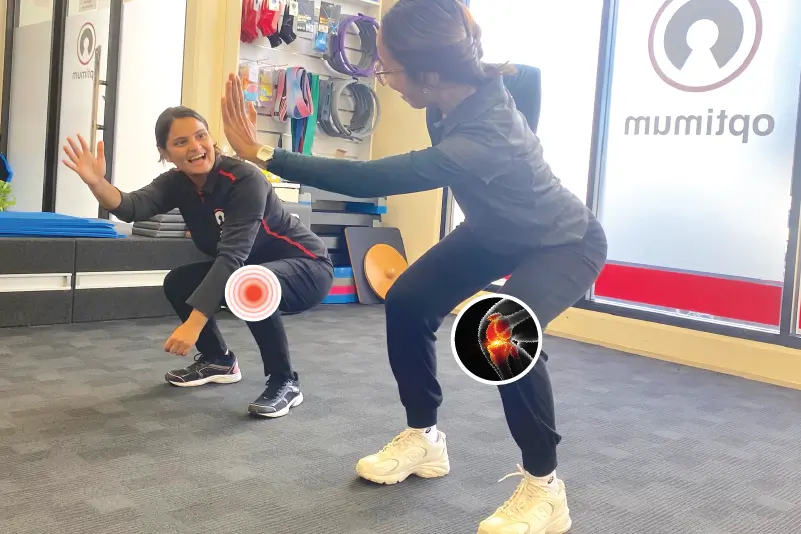Ah, the squat. The king of all exercises, the bane of many knees, and the perfect position to contemplate life’s mysteries, like why we ever started squatting in the first place?! But the burning question remains: how deep should we go?
The Squats and Knee Pain
For the uninitiated (or those who avoid leg day like it’s a bad cold), a squat involves bending at the knees and hips to lower your body, then returning to a standing position. It’s a simple movement that can range from a slight dip to a full-on “I dropped my keys, and now I’m practically sitting on the ground” squat. The depth of your squat can be measured by the angle of your knee and hip joints or, more practically, by how much you’re sweating and regretting your life choices.
To 90 Degrees and Beyond!
A common guideline is to squat until your thighs are parallel to the ground, creating a 90-degree angle at the knee. This position is like the comfortable middle child of the squat family—not too shallow, not too deep, just right. It’s often recommended because it balances muscle activation and joint safety. A study published in the Journal of Strength and Conditioning Research found that squatting to 90 degrees activates the quadriceps and glutes efficiently while minimising stress on the knee joints.
The Deep Squat: A Risky Romance in Knee Pain
The deep squat, also known as the “ass-to-grass” squat, is where you lower your hips below your knees. It’s the holy grail for some fitness enthusiasts and a ticket to the orthopaedic office for others. While it engages more muscles, especially in the glutes and hamstrings, it also increases the strain on your knees and lower back.
Patellofemoral Pain Syndrome (Runner’s Knee) in Squats
Research by Hartmann et al. (2013) in the Sports Medicine journal suggests that deep squats can be safe for the knees if performed correctly and with adequate mobility. However, they also caution that individuals with pre-existing knee issues or insufficient flexibility should approach deep squatting with caution. The increased knee flexion can put additional stress on the patellofemoral joint and the ligaments, potentially leading to injuries such as Patellofemoral Pain Syndrome (PFPS), commonly known as “runner’s knee”.
Knee Pain in Action
Let’s talk about Mike, a gym-goer who decided to embrace the deep squat trend without proper preparation. Mike pushed himself into a deep squat despite feeling tightness in his knees. A few weeks later, he was in my clinic, complaining of pain around the front of his knee, particularly under the kneecap. He was diagnosed with Patellofemoral Pain Syndrome, a condition often caused by overuse, muscle imbalances, or poor alignment during squats. Mike’s enthusiasm for deep squats had outpaced his knee’s readiness, and now he was paying the price. His story is a cautionary tale: deep squats can be beneficial, but only when your body is ready for them.
The Goldilocks Zone: Finding Your Ideal Squat Depth
Ultimately, the perfect squat depth is like the perfect pizza topping—it’s personal. Factors like your flexibility, strength, and any existing injuries play a role. A good rule of thumb is to go as deep as you can while maintaining good form and without experiencing pain. At Optimum Clinic, we can help you assess your body’s capacity to squat safely and effectively, ensuring you get the benefits without the risks.
Brace for Knee Pain during Squats
For added support and to protect your knees, consider using a knee brace. At Optimum Clinic, we offer a range of knee braces to suit your needs. Our experts can help you choose the right brace to support your squatting activities and prevent injuries.
Optimum Physiotherapy Clinic’s Take on Knee Pain and Squats
As a physiotherapist, we often see people either avoiding squats like the plague or going too deep too soon. The trick is to build strength and mobility progressively. Start with bodyweight squats, work on your form, and gradually add depth and weight. And if in doubt, consult with a professional like us here at Optimum Clinic—because nothing says “bad day” like a squat gone wrong.
A Squat-tastic Conclusion
So, how deep should you squat? The answer, dear reader, is as deep as your body allows comfortably and safely. Whether you’re a parallel squatter, a deep squatter, or somewhere in between, remember that the squat is a versatile exercise that can be tailored to your needs. And if you’re still unsure, give us a call and we’ll help you achieve your goals. Get the “New Patient Special” offer and save $113! This includes assessment, treatment and management plan. Visit our web page to sign up.
And remember, when life gets tough, squat lower. It’s harder for life to hit you in the face that way!
Read more about What we do and What we treat.

